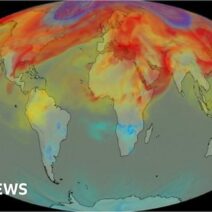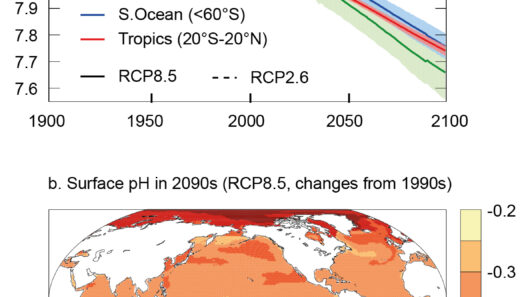The enigmatic planet Venus, often dubbed the “morning star” or “evening star,” radiates an allure that belies its inhospitable environment. Orbiting our Sun as the second planet from it, Venus has captivated astronomers and scientists for centuries, not merely for her radiant appearance but also for her extreme climatic conditions. To understand Venus is to traverse through a maelstrom of thick clouds, unbearable temperatures, and relentless atmospheric pressure, rendering it the hottest planet in the solar system.
As one delves into the climate of Venus, it can be likened to stepping into a vast, suffocating sauna: the air is laden with moisture, yet it contains no relief—only oppressive heat. A study of Venus’s atmosphere reveals a landscape unforgiving to life as we know it. Temperatures soar to an average of approximately 467 degrees Celsius (872 degrees Fahrenheit), a blistering furnace caused by an intense greenhouse effect. Without a hint of irony, this celestial body serves as a dire warning to Earth regarding the perils of excessive greenhouse gas emissions.
The thick atmosphere surrounding Venus consists predominantly of carbon dioxide, about 96.5%, fostered by the planet’s geological history and lack of a significant water presence. The clouds that cloak Venus are laden with sulfuric acid—an inhospitable blanket that casts a vivid golden hue across the planet. These clouds do not provide shelter; rather, they act as a barrier, trapping heat in an almost Venusian twist of fate. The greenhouse effect is pronounced here, as sunlight penetrates the thick clouds but fails to escape, creating a ceaseless cycle of heat accumulation.
One can imagine Venus as an exquisite jewel locked within a blacksmith’s forge—its beauty rendered almost unbearable through the blistering temperatures surrounding it. The immense pressure at the surface is about 92 times that of Earth, akin to being nearly a mile deep in our oceans. This atmospheric weight contributes to a perpetual storm, as winds whip around the planet at swirling speeds that can reach up to 360 kilometers per hour (about 224 miles per hour) in the upper atmosphere, transforming it into a realm where turbulence reigns supreme.
Yet, beneath this ferocious façade lies another enigma: the planet’s geological characteristics. Despite the extreme conditions, Venus exhibits a wide array of landforms, including vast plains, highland regions, and numerous volcanoes. The plains may be smoothed by lava flows, suggesting a dynamic geological history marked by both violent eruptions and gradual resurfacing over eons. Radar mapping from various missions reveals that at least 1,600 volcanoes dot its surface, some of which may still be geologically active. The lingering question arises: how does such fierce climate conditions affect geological processes on Venus?
Interestingly, the lack of water on Venus creates a distinctly different cycle compared to Earth’s hydrological cycle. While Earth’s water evaporates, condenses, and rains down, Venus’s atmosphere perpetuates its own cycle of sulfuric acid, leading to acidic rain that evaporates before it can reach the surface. This process accentuates the planet’s parched nature, underscoring an almost tragic irony in its once-thought potential for habitability.
Looking beyond the current inhospitable conditions, scientists speculate about Venus’s past—a time when oceans may have adorned its surface. Some studies postulate that billions of years ago, Venus could have had significant water, possibly supporting life. Given this hypothesis, Venus serves as a poignant reminder of the delicate balance required for sustaining an atmosphere conducive to life. Its evolution highlights the disastrous consequences of a rapidly changing environment, while also illustrating how planets can metamorphose under different circumstances.
Comparable to the trials faced by modern Earth, Venus stands as an emblematic figure in discussions surrounding climate change. The planet’s warming offers a cautionary tale regarding the greenhouse effect and its catastrophic potential if left unchecked. As inhabitants of Earth recklessly pursue industrial expansion, Venus acts as a somber oracle, warning against the unsustainable habits that could render our blue planet equally uninhabitable.
In the grand tapestry of our solar system, Venus embodies a multitude of contradictions: dazzling yet deadly, seductive yet suffocating. It is a reminder that beauty can conceal peril, a vivid juxtaposition to Earth’s temperate climates—reminding us to appreciate the nuanced balance of our own environment. The lessons that Venus imparts extend beyond mere scientific inquiry; they penetrate the very core of our responsibilities in safeguarding our planet.
Thus, as we peer into the heavens and examine the allure of our celestial neighbors, we must take heed of Venus’s stark climate. The sizzling temperatures and tumultuous atmosphere may speak to a future we must strive to avert—a future where excessive greenhouse gases lead to an Earth reminiscent of our neighboring planet. In this regard, Venus serves not only as a topic of fascination but as a clarion call to enact change, to preserve our home, and to honor the delicate equilibrium that sustains life.








